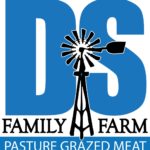Worried about what you are "really" eating? Have peace of mind with pasture grazed meats.
2024 Omega 6:3
This marks our tenth year of collecting Omega 6:3 Ratio data on our harvested Grassfed (Pasture Grazed) Beef. This testing generally costs around $250 per sample. We simply take a frozen beef sample, usually ground beef, to Midwest Labs in Omaha Nebraska. The lab runs an overall fat analysis and detailed fatty acid analysis. The beef sample for 2024 was from a fall harvested steer with an O6:3 Ratio of 2:1. Our annual updated chart is displayed below:
We have discussed many aspects of the Omega 6:3 Ratio and why we measure it in our past posts, you can scan through all our past posts related to O6:3 testing using this link, all past Omega 6:3 posts.
Your diet will decide your Omega 6:3 ratio. For cattle, herbivories, their primary diet consists of plants. So why do cattle primarily eating the leaf portion of plants have a low O6:3 ratio and cattle primarily eating the seed/grain of plants have a high O6:3 ratio?
Green Leaves = Omega 3 Fats
When you see green, think Omega 3 fat/lipids. But what do we know about leaves of plants? They are highly perishable. If a leaf gets cut off, its color will fade as the leaf quickly withers. The Omega 3 Fats are therefore highly perishable. It is almost December here in Nebraska and most of our native warm season grasses have turned brown, the Omega 3 in the leaves of these grasses are gone. The cattle simply are not getting as many Omega 3 fats in their diet right now as they would during our green grass growing season.
Plant Seeds = Omega 6 Fats
For plants to survive into the future, they program their survival into their seeds. The seed must have an energy source such as fat, but we know Omega 3 Fats are perishable. So the plant packs its seeds with Omega 6 Fats that are not perishable. Omega 6 Fats are stable and will last for long periods of time, until the seed finds the right conditions to sprout and grow into a new plant.
“Vegetable Oil” = “Seed Oil”
Hopefully the above two photos make it clear why cattle eating primarily green growing grass will have a LOW Omega 6:3 ratio. While cattle fed a high grain diet in a feedlot will have a HIGH Omega 6:3 ratio. As we have previously explained in past posts, both fats are essential for our health. Omega 3 fats are anti-inflammatory where the Omega 6 fats are inflammatory. Under different situations, are bodies need to access both of these functions. The problem with the current Standard American Diet is that we have way to many Omega 6 fats in our diet.
Most processed foods will have seed oils. You probably cook some of your food at home in “Vegetable Oil” which is a nice marketing name for “Seed Oil”. Almost all food at restaurants are cooked in Seed Oils. This results in an over abundance of Omega 6 Fats in many of us. We are in a constant state of inflammation due to our overconsumption of Omega 6 Fats.
The quickest way to improve your Omega 6:3 ratio is to eliminate Seed Oils from your diet. You might be amazed how you feel once you lower your Omega 6:3 ratio.
Best way to lower O6:3 Ratio in cattle
The pastures here at DS Family Farm are predominantly Warm Season Native Grasses. When we embarked on our effort to raise “grassfed beef”, the grazing Guru’s warned us it would be difficult to do “grassfed” on native warm season grasses. Thankfully we have been successful in our efforts so far. The key has been grazing management and the right kind of cow that can work with the forages we have available.
In reading the studies on O6:3 in grazing animals, pastures high in legumes and cool evenings will result in the lowest 06:3 ratio at harvest. We simply try to harvest our animals off green growing grass. If it happens to be at the time of year when we have cool evenings, all the better.








